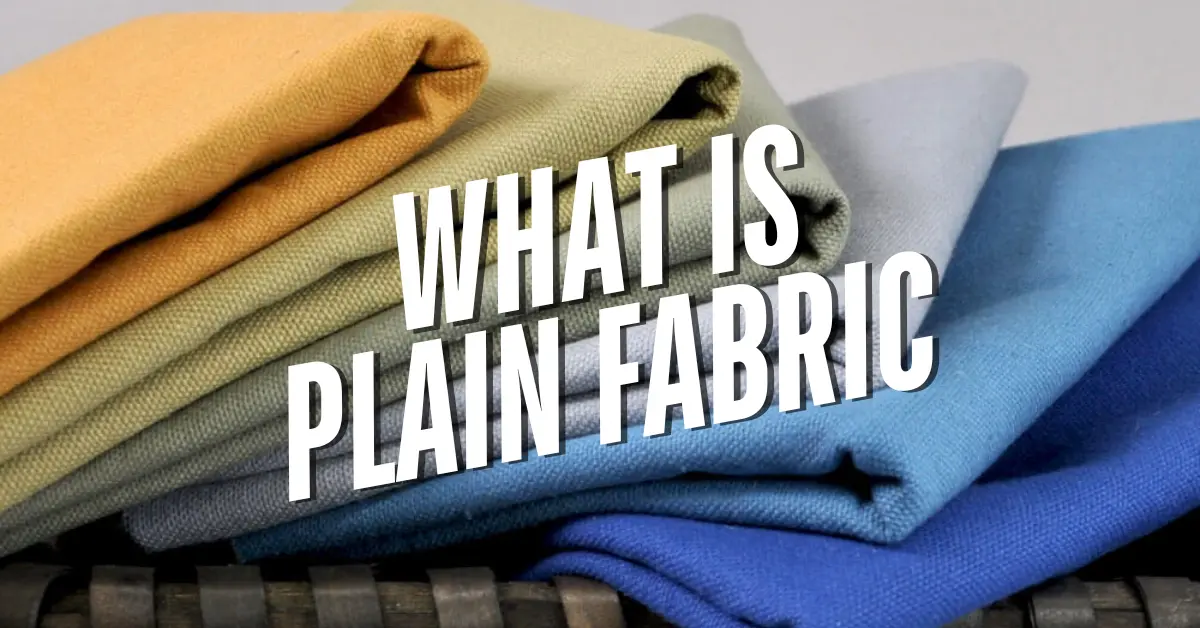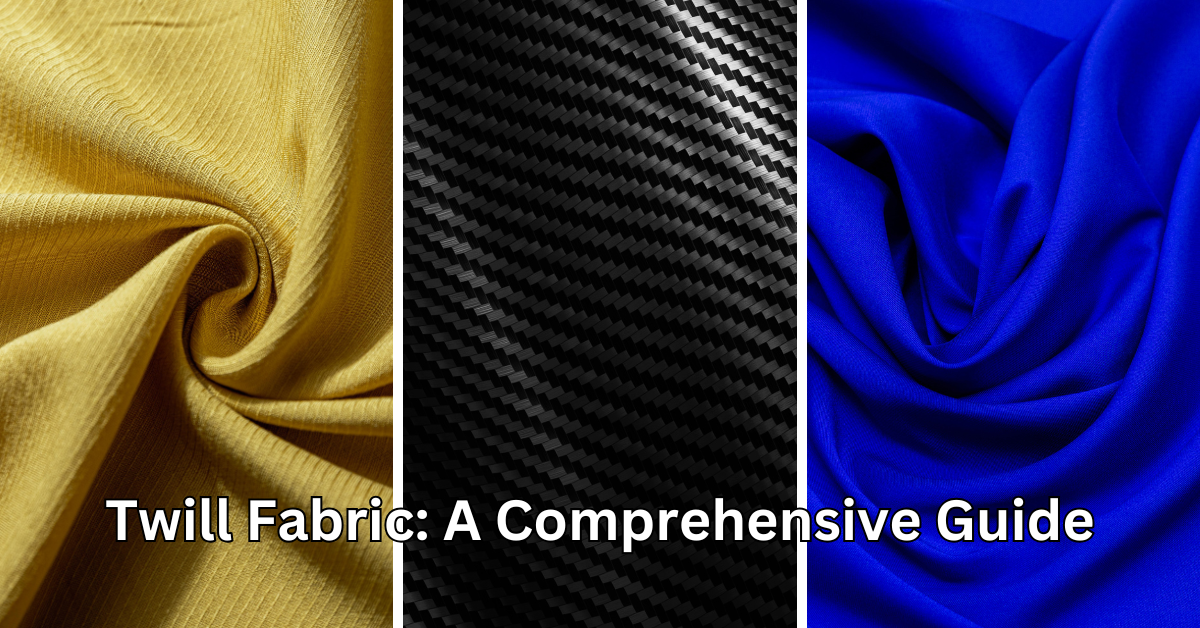Understanding Steep Twill Weave
Steep twill weave is a specific variation of the traditional twill weave. This textile structure is characterized by a steep diagonal pattern, typically with an angle of 63 degrees, which gives it unique properties that make it popular in both apparel and home textiles. In this article, we will explore the technical aspects, applications, advantages, and maintenance of steep twill weave fabrics, providing insight into how this weave type stands out in the textile industry.
What is Steep Twill Weave?
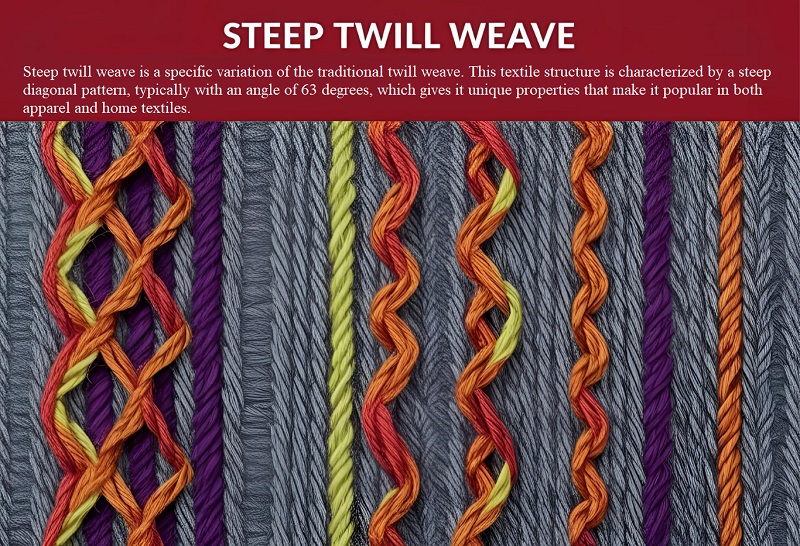
Definition and Characteristics
Twill weave is a pattern where the weft (crosswise) thread passes over one or more warp (lengthwise) threads, creating a diagonal line. The “steep” part of the steep twill weave refers to the angle of this diagonal. Unlike standard twill, which has a shallower angle, steep twill features a more pronounced slant, often around 63 degrees. This gives the fabric a distinct texture and contributes to its visual and physical properties.
In steep twill, the diagonal lines are more pronounced, offering a smoother finish and stronger fabric structure. The steepness of the angle increases the fabric’s durability, making it ideal for heavy-duty applications where strength and longevity are crucial.
Technical Aspects of Steep Twill Weave

Weave Structure and Angle
The primary feature of steep twill weave is its sharp diagonal. This is achieved by altering the number of warp and weft threads that overlap. The steeper the angle, the greater the number of threads involved in the weave pattern. The increased thread interaction contributes to the fabric’s sturdiness.
The steep angle not only affects the appearance of the fabric but also its functionality. Fabrics made with steep twill weave are known for their durability and resistance to wear. The fabric’s structure allows for a higher level of flexibility and resilience, making it less prone to fraying or distortion.
Impact on Fabric Properties
The angle of steep twill weave has a direct impact on its strength, drape, and overall performance. A fabric with a steeper angle tends to be more durable, as the tight weave reduces the likelihood of thread breakage. The structure also enhances the fabric’s resistance to abrasion, making it suitable for high-stress applications.
Additionally, steep twill fabrics often have a smooth, lustrous finish due to the way light interacts with the diagonal lines. This makes them visually appealing and more suitable for high-end garments or home décor items that require a refined look.
Applications of Steep Twill Weave
Apparel Industry
Steep twill weave is widely used in the apparel industry, particularly for creating sturdy garments like suits, trousers, and jackets. The durability of this weave makes it ideal for clothing that undergoes frequent wear and tear. Its smooth finish and structured feel contribute to a professional appearance, making it a preferred choice for formal wear.
Steep twill weave is also used in outerwear such as coats, where its strength provides protection against the elements. The fabric’s ability to retain shape even under pressure ensures that these garments maintain their form and function for extended periods.
Home Textiles
Apart from its application in clothing, steep twill weave is commonly found in home textiles. Upholstery fabrics, for example, benefit from the wear-resistant properties of this weave. The structure adds a level of sophistication and durability to furniture covers, ensuring they last longer and maintain their aesthetic appeal.
Draperies and curtains made from steep twill weave are also popular for their strength and smooth texture. These fabrics are less likely to sag or lose their shape over time, making them an excellent choice for both residential and commercial spaces.
Advantages of Steep Twill Weave
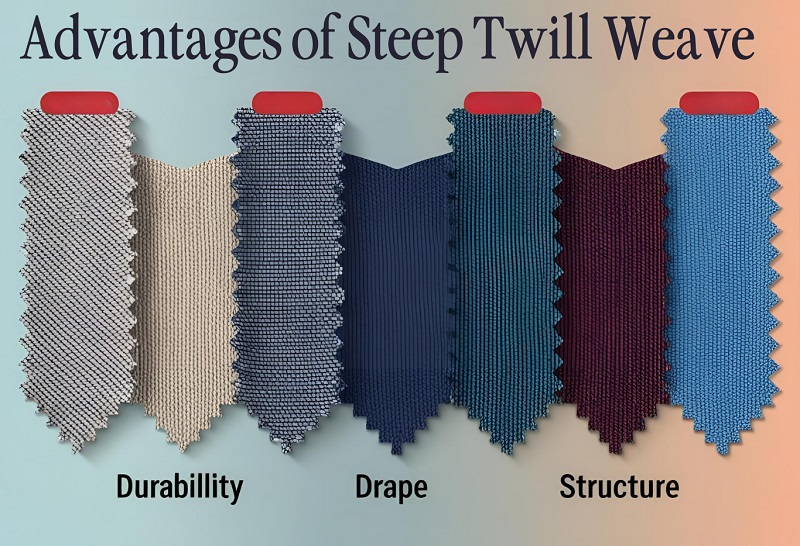
Durability and Strength
One of the standout features of steep twill weave is its durability. The steep angle of the weave ensures that the fabric is strong and resistant to abrasion, making it ideal for heavy-duty applications. Whether used in clothing or home textiles, steep twill fabrics are built to last. The dense weave structure provides excellent tensile strength, reducing the chances of fabric breakage under pressure.
Aesthetic Appeal
In addition to its durability, steep twill weave also offers a unique visual appeal. The diagonal lines created by the weave pattern give the fabric a textured surface that reflects light differently, creating a subtle sheen. This makes steep twill fabrics ideal for formal wear and high-end home textiles, where both strength and appearance are important.
The smooth finish and the depth of texture make steep twill a versatile choice for a wide range of applications, from luxury garments to durable upholstery fabrics.
Comparison with Other Twill Weaves
Regular vs. Steep Twill
While both regular and steep twill weaves share the basic diagonal structure, the angle of the diagonal sets them apart. Regular twill weaves have a more shallow angle, typically around 45 degrees, while steep twill weaves have a sharper angle, around 63 degrees. This difference influences the fabric’s strength, texture, and appearance.
In terms of durability, steep twill is superior due to the increased thread overlap and tighter weave. It also offers a more pronounced diagonal pattern, which can be more visually appealing depending on the desired effect.
Applications Based on Twill Angle
The angle of the twill weave affects the fabric’s suitability for various applications. Steep twill fabrics, with their sharper angle, are better suited for heavy-duty applications where both strength and visual appeal are necessary. Regular twill, on the other hand, is often used for lighter fabrics like casual clothing or linens, where flexibility and ease of use are more important.
Care and Maintenance of Steep Twill Fabrics
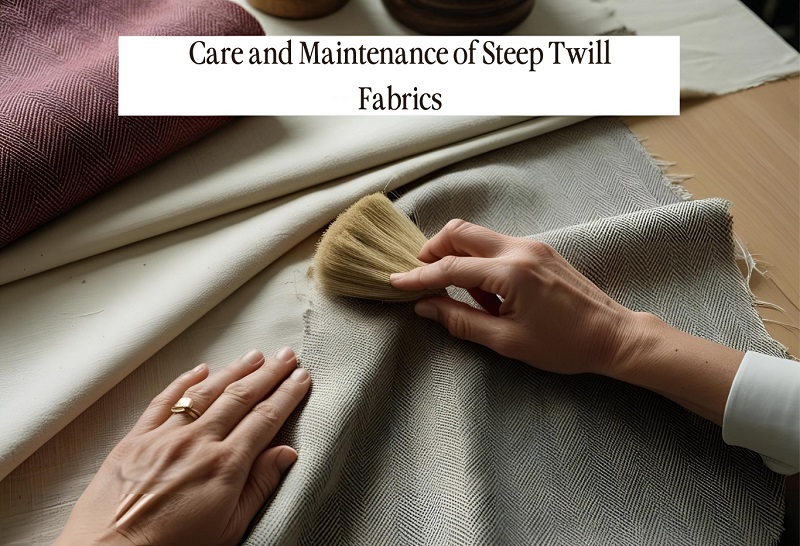
Cleaning Guidelines
To maintain the integrity of steep twill fabrics, proper care is essential. Most steep twill fabrics can be machine washed on a gentle cycle, but it’s always best to check the manufacturer’s instructions. To prevent distortion of the weave pattern, avoid using harsh detergents or high heat. Dry cleaning may be recommended for certain types of steep twill, particularly in high-end garments.
Storage Tips
When storing steep twill fabrics, ensure that they are kept in a cool, dry place to prevent damage from moisture. For garments, use padded hangers to preserve the shape of jackets or trousers. For upholstery, consider rotating furniture cushions periodically to distribute wear evenly.
Conclusion
Recap of Steep Twill Weave Benefits
Steep twill weave offers a unique combination of durability, strength, and aesthetic appeal. Its sharp diagonal pattern makes it an ideal choice for a variety of applications, from high-end clothing to durable home textiles. The steep angle not only contributes to the fabric’s strength but also enhances its visual texture.
Future Trends
As textile technologies continue to evolve, we may see innovations in steep twill weave fabrics, particularly in terms of sustainability and performance. New materials and manufacturing techniques could further enhance the benefits of this weave, making it even more versatile and eco-friendly for future applications.
Steep twill weave remains an essential fabric structure in both the fashion and textile industries. With its exceptional durability and unique appearance, it continues to be a top choice for a wide range of products, combining function with style.
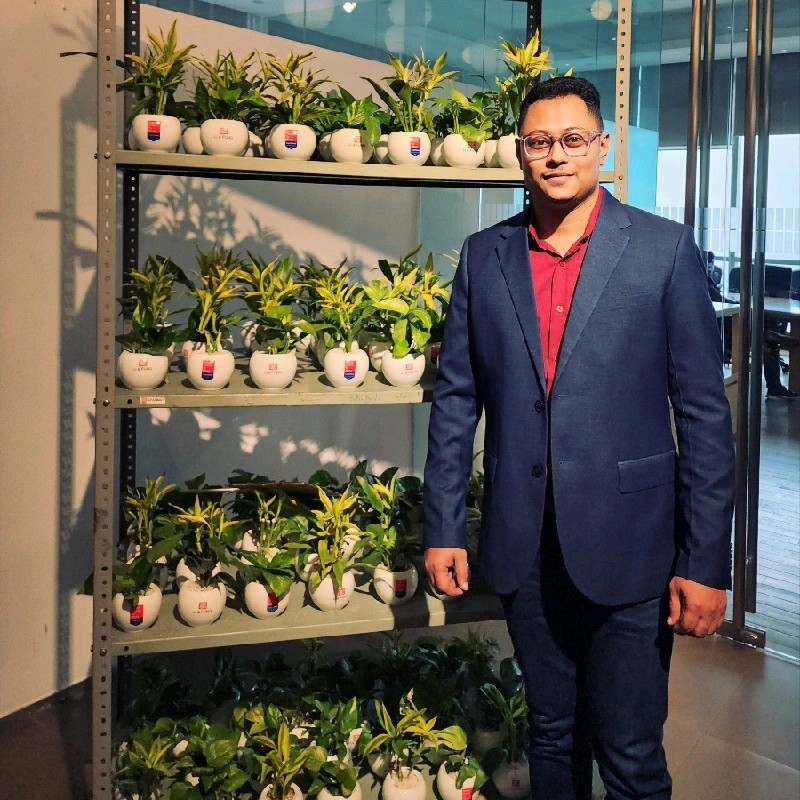
Manager – Fabric Technical and Sourcing/Product Development/ Sustainable Material Management.
I am a B.Sc .-educated Manager of Fabric Sourcing and Technology with extensive experience in the apparel and fashion industry. Passionate about trend analysis, fabric sourcing, and sustainable textile solutions, I thrive in fast-paced environments that demand innovation, adaptability, and leadership.
As a servant leader, I am committed to honesty, transparency, and continuous process improvement. My expertise spans fabric development, product quality management, and supply chain optimization, ensuring exceptional performance across all facets of sourcing and production.
Core Skills & Expertise
✔ Fabric Sourcing & Development – Specialized in regular and sustainable textiles (BCI, Organic, Recycled).✔ Trend Analysis – In-depth understanding of global fashion and fabric trends.✔ Product Development – Expertise in material innovation and process optimization.✔ Quality Management – Strong focus on process control, ensuring high-quality production.✔ Leadership & Problem-Solving – Solution-oriented approach to team management and decision-making.
Technical Proficiency
🖥 Software & Tools:▪ Microsoft Outlook, Excel, Word▪ PLM (Product Lifecycle Management)
🌱 Sustainable & Ethical Practices:▪ Better Cotton Initiative (BCI)▪ Organic & Recycled Fabric Management
Key Strengths
✅ Solution-Focused Leadership – Driving innovation and efficiency in fabric sourcing.✅ Quick Decision-Maker – Adapting to market shifts and production challenges.✅ Team Player with a Positive Attitude – Ensuring collaboration and productivity.✅ Strong Time Management – Meeting deadlines while maintaining quality.
Professional Achievements
🏆 Li & Fung GEM Award – Recognized for fabric sourcing and supply chain management excellence.🏆 Group CEO GEM Award – Honored for outstanding leadership and process innovation.
